Meat production is increasing due to population growth and rising purchasing power, with poultry being particularly in demand. Soybean production, mainly for animal feed, has also grown significantly. To make poultry production more sustainable, reducing crude protein in diets is suggested, which has both environmental benefits and economic challenges.
1. Societal and environmental concerns:
1.1 Meat production:
The world population continues to increase; on November 15, 2022, the figure of 8 billion people was surpassed, and it is expected that in the next 30 years it could increase by 2 billion more people (FAO, 2024). Population growth is also associated with an increase in purchasing power and this means that meat production continues to grow (Figure 1).
The strong consumer demand leads to an increase in poultry production, especially in chicken meat, as chicken remains affordable despite inflationary pressures worldwide (Figure 2). However, the industry still faces challenges, including outbreaks of Highly Pathogenic Avian Influenza.
The FAO predicts a 0.8% year-on-year growth, adding 1.1 million tons to reach a total of 146 million tons. Poultry meat consumption will reach 91 million tons by 2032, thanks to the social perception of this food and the lower price of poultry meat compared to other types of meat.
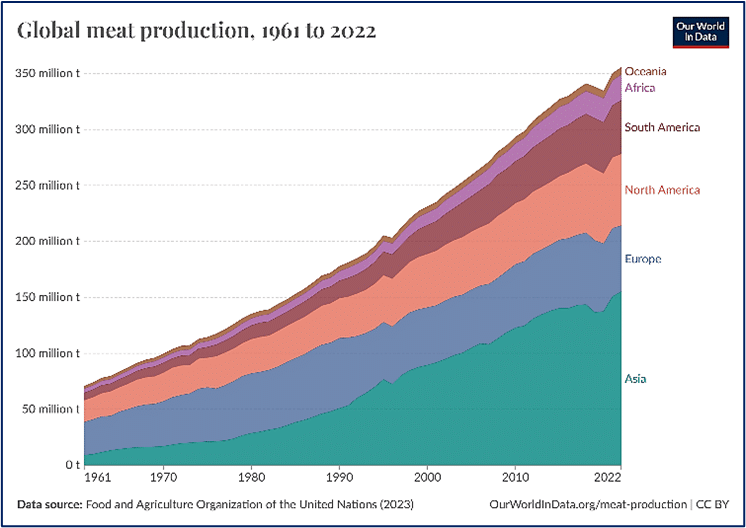
Figure 1: Global meat production from 1961 to 2022 (OurWorldInData.org)
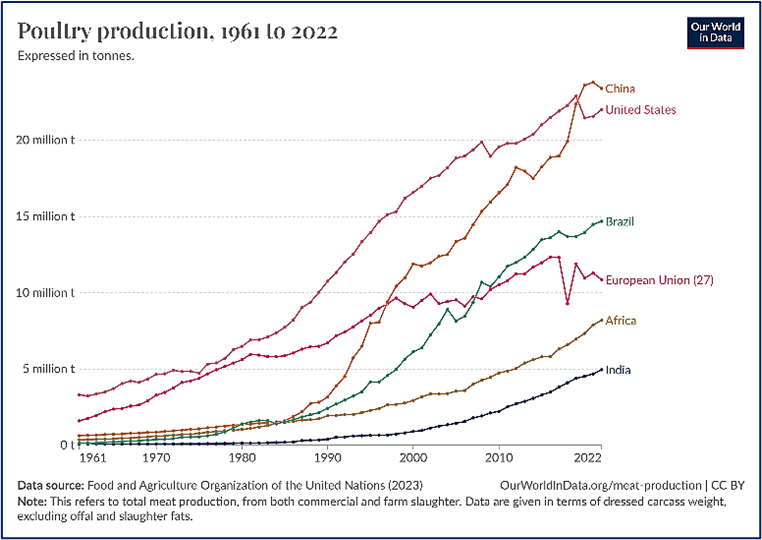
Figure 2: Poultry production from 1961 to 2022 (OurWorldInData.org)
1.2 Soja production:
Soybean is the protein par excellence in monogastric feed, and its growth has also been exponential (Figure 3). Only 20% worldwide of soybean production is for human consumption, 4% is for industry and the remaining 76% is for animal feed, of which 37% is for poultry production (Figure 4).
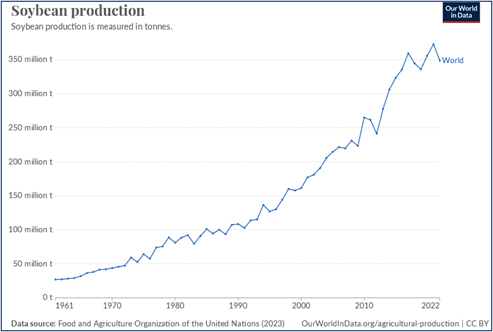
Figure 3: Soybean production from 1961 to 2022 (OurWorldInData.org)
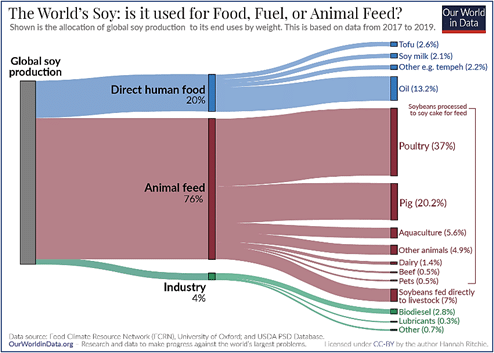
Figure 4: The world’s soy: is it used for food, fuel or animal feed (OurWorldInData.org)
Its universal acceptability in animal feed is due to important attributes such as its relatively high protein content and suitable amino acid profile except for methionine, its year-round availability, and its relative freedom from intractable antinutritive factors if properly processed (Dei, 2011). However, the price of soybean meal (SBM) is high and volatile, and poultry production can be more sustainable.
In poultry production, reducing feed costs, improving animal protein supply and ensuring sustainability are important concerns. Nowadays crude protein (CP) is a crucial and expensive component of the diet, and current levels of CP are an economic consequence of balancing for amino acids.
To achieve these new challenges, an alternative might be to formulate with low protein diet which is based on amino acids balance, amino acids synchronization and glucose metabolism. Reduction of CP is a straightforward way to lower nitrogen emissions and leading to lower feed costs (Koeleman, 2023).
2. How to lower dietary crude protein (CP)?
Low crude protein in a standard corn/soybean diet generally involves a decrease in soybean meal while increasing the proportion of grain content. This change increases dietary starch (it’s more digestible due to a higher ileal digestibility coefficient than protein and amino acids) and decreases dietary lipid levels. To meet nutritional needs, these diets also include higher amounts of crystalline (synthetic) amino acids (Selle, P & Liu, S, 2018; Leeson 2023).
According to Stokvis (2024), there are 3 ways to lower the crude protein in the poultry feed diet:
a) Choosing feedstuffs with:
- High content of amino acids (AA) in crude protein (CP)
- High digestibility of essential and non-essential AA (EAA and NEAA) with ideal amino acids profiles
b) Formulating diets close to requirements for digestible amino acids
c) Improving the efficiency of digested protein
Nowadays the CP levels for broilers are more or less low as below:
- Starter (0d – 10d): from 21% to 19%
- Grower 1 (10d – 20d): from 20% to 18%
- Grower 2 (20d – 30d): from 19% to 17%
- Finisher (30d – 40d): from 18,5% to 16,5%
When reducing crude protein (CP) in the feed diet, different researches are defining interrelationships of nutrient digestibility and absorption. A reduction in CP of 20 – 30 g/kg maintains performances and processing yields. Lowering CP more than 30 g/kg has been shown to inhibit performance and increase adipose fat deposition (Van Harn, J et al., 2019; Liu, S et al., 2019).
| Item | Characteristic |
|---|---|
| Ingredient matrix | |
| Soybean meal | Improved varieties: amino acid levels and digestibility, carbohydrate fraction adjustments, improved oil content, and ability to utilize full fat beans |
| Increasing feed phases | Adding diet phases allows for closer meeting the birds’ need and minimizing excesses |
| Sex separate feeding | As female broilers require an order of 10 to 15% less amino acid levels, this strategy can increase nitrogen efficiency |
| Nutrient matrix | |
|---|---|
| Protein level | Less dependence on diet protein and more on amino acid supply by formulating to non-essential amino acids |
| Digestive dynamics | As CP decreases, more cereals enter diets with less dietary oil sources. The feed grade amino acids interact with starch regarding digestion. Ratios are needed to limit rapid starch in low CP diets |
| Non-essential amino acid levels | As protein continues to be reduced, using nutrient minimums for non-essential amino acids will be required to maintain a nitrogen pool |
| Electrolyte balance | Reduced protein results in less soybean meal and monitoring electrolyte balance from the potassium reduction is critical |
Table 1: On reduced crude protein diets for broilers: Some considerations for the linear programming matrices (Kidd, 2021)
Once we have the formulation adjusted to theoretical values, we should be able to take it to the field production. At this point, we have to take into account the different consequences.
3. What are the consequences?
✅ Positives
- Reduces N excretion
- Reduces water intake (positive impact on litter quality)
- Less footpad condition, improve animal welfare
- Reduces dependency on soybean meal (SBM) inclusion
- Sustainable alternative
- Improves dietary net energy
✖️Negatives
- Diets often more expensive: Free AA price
- Free AA competition with glucose for uptake by Na+ dependent transport system
- Less catabolism of AAs in gut mucosa: Free AA are absorbed more proximal in the small intestine than protein bound AA
- Increases abdominal fat deposition: Less energy needed for protein catabolism, then more energy used for fat deposition
- Alters dietary electrolyte balance (dEB): Low CP diets result in lower inclusion of SBM which reduces the dEB because of the lower K level.
4. Some key recommendations for formulation:
- Formulate based on digestible amino acids
- Focus on the ideal AA profile
- Focus on starch and fat levels
- Set a minimum of dietary electrolyte balance (dEB)
Nowadays it is not possible to exclude completely the use of soybeans in poultry feed formulation. There are no raw materials that, in terms of price and/or volume, can cover market needs. If low crude protein diets are going to be more relevant in the future, it is necessary then to have a list of solutions to deal with the different negative consequences like correcting the dEB balance.
5. A proper dietary electrolyte balance (dEB) and Phosphea minerals solution:
5.1 Dietary electrolyte balance definition and calculation:
Electrolyte balance is the net balance between fixed cations (Na+ and K+) and anions (Cl-) in mEq/kg of diet (Mongin, 1980) These essential ions maintain osmotic pressure and acid-base balance of body fluids, so birds’ metabolic and digestive systems perform at maximum efficiency (Bishnoi, 2020). The following method is used to calculate it:
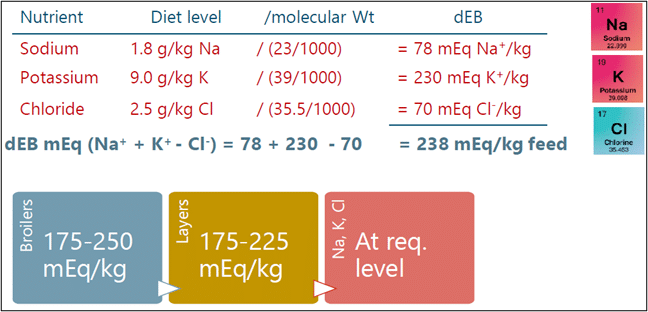
Figure 5: Dietary electrolyte balance (dEB) calculation and poultry requirements (SFR, 2024)
5.2 Feed formulation and its impact on dEB:
In a current feed diet formulation, the dEB is quite high when feed has a high protein content (High potassium). However, by reducing protein in the diet, the dEB may be reduced below 160 mEq/kg and may become problematic. It’s therefore important to follow the correct requirements and avoid excesses or deficits of dEB (Table 2):
| High dEB | Low dEB |
|---|---|
| Diets with high Na/K or low Cl | Increase Ca mobilization |
| Increase water intake | Reduce eggshell quality |
| Increase litter moisture | Increase bone disorders |
| Increase footpad dermatitis | Increase N excretion |
| Decrease performance | Decrease protein efficiency |
Table 2: Consequences of extreme dEB levels (SFR, 2024)
While the type of protein source in the diet plays an important role in dEB balance, other raw materials also have an impact on this (Table 3):
| Raw materials | EB (mEq/kg) |
|---|---|
| Wheat | 85 |
| Corn | 71 |
| Soybean meal | 571 |
| Rapeseed meal | 336 |
| Oats | 87 |
| Sunflower seed meal | 378 |
| Meat and bone meal | 241 |
| L-Lysine HCl | -5 464 |
| Salt | 29 |
| Sodium bicarbonate | 11 800 |
Table 3: Feedstuffs and dEB levels (SFR, 2024)
5.3 Feed supplementation to correct dEB balance:
If the diet does not deliver the correct dEB level, feed supplementation is needed to ensure the proper use of cations and anions for optimal poultry performance. Two main steps that should be monitored are the feedstuffs analysis and the proper mineral supplementation to obtain the correct dEB in the ration (Bishnoi, 2020).
- Using salt does not contribute to the value of dEB value since it contains a cation and an anion with similar weights.
- Using sodium bicarbonate tends to neutralize acids with negative impact on performance (Technical department Perstorp, 2019)
- Using sodium without chloride as a first choice, it will increase correctly the dEB and sodium is the most important mineral in the active transport processes of vital nutrients across biological membranes. A nutritionist must follow a minimum requirement for sodium, without exceeding the maximum chloride requirement.
| Raw materials | EB (mEq/kg) |
|---|---|
| Wheat | 85 |
| Corn | 71 |
| Soybean meal | 571 |
| Rapeseed meal | 336 |
| Oats | 87 |
| Sunflower seed meal | 378 |
| Meat and bone meal | 241 |
| L-Lysine HCl | -5 464 |
| Salt | 29 |
| Sodium bicarbonate | 11 800 |
| NEOPHOS | 2 200 |
| MSP | 6 900 |
Table 4: Feedstuffs and dEB levels (SFR, 2024) and Phosphea minerals supplementation:
The options for a proper dietary electrolyte balance (dEB) are well known and studied, but it should be noted that choosing the right feed supplement is essential to avoid the consequences of excesses or deficiencies in some minerals (Na+ or Cl-, for example).
As shown in Table 4, Phosphea proposes 2 solutions: Monosodium phosphate (MSP) and sodium calcium phosphate (NEOPHOS), providing chloride-free sodium which allows to decrease or replace other source of sodium in the diet and impact positively the dEB of animals.
Author: Jetsabell GUTIERREZ VALLEJOS